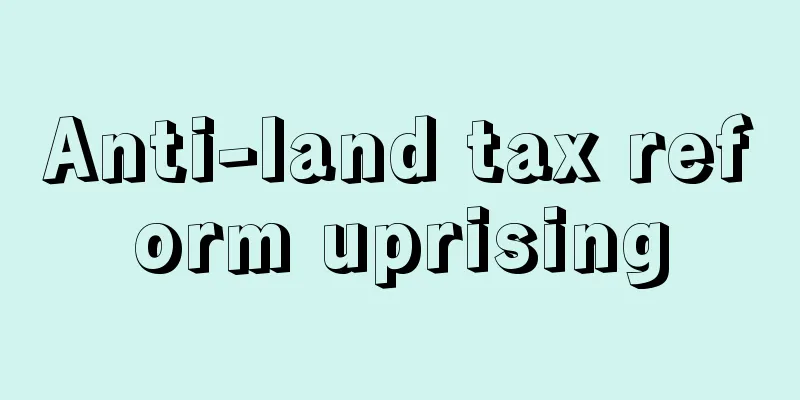Anti-land tax reform uprising

|
The uprisings began in July 1873 (Meiji 6) in opposition to the land tax reform. The reform, which was implemented by forcibly imposing a high estimated land tax that was unchanged from the old tribute tax, created widespread discontent among farmers. This led to various resistance and even uprisings against the tax increase all over the country, mainly in areas where the tax was increased, and the number of such cases exceeded 50. The uprisings against the land-tax reform can be divided into the following two types/stages. The first type was characterized by violent acts such as destruction and burning, and all of them occurred in the early stages of the land-tax reform project (1876). These are typified by the uprisings in the Naka and Hidaka counties of Wakayama Prefecture, the Ise Riots that spread to the four prefectures of Mie, Aichi, Gifu, and Sakai (present-day Nara), and the uprisings in the Naka and Makabe counties of Ibaraki Prefecture. These uprisings had a great impact on the government, and they won a concession to reduce the land-tax rate (from 3% of land prices to 2.5%). However, this type had various limitations in terms of organizational form and the quality of demands, and it was the initial form/stage of the uprisings against the land-tax reform. On the other hand, the second type was characterized by not taking a violent form, but rather taking the form of a long-term, persistent opposition movement against the prefecture and the government (the Land Tax Reform Bureau). This is typified by the uprisings in Kambara County, Niigata Prefecture, the seven Echizen counties in Ishikawa Prefecture (present-day Fukui Prefecture), Kasugai County, Aichi Prefecture, and Ina County, Chikuma Prefecture (present-day Nagano Prefecture). In terms of organizational form and the quality of demands, this type was the original form/stage of the uprisings against the land tax reform. That is, these uprisings developed as an all-out confrontation against the land tax reform project at the stage when it was in full swing. In terms of organizational form, they were fought by a wide range of farmers, including landlords, centering on the demand against the imposition of high land taxes (tax increases). In terms of the quality of the demands, while opposition to the land-tax reform was centered on opposition to the resulting tax increase, it did not stop there; it was based on criticism of the land-tax reform itself, including criticism of the injustice of the process of determining land prices and the method of calculating land prices. Due to these characteristics, the anti-land-tax reform uprising contained an opportunity to develop beyond the limitations of traditional peasant uprisings. It also formed the basis for the nationwide expansion and rise of the Freedom and People's Rights Movement, by greatly shaking up the political consciousness of the peasants, and by linking and developing into the Freedom and People's Rights Movement. In this way, the anti-land-tax reform uprising became a transitional movement from an isolated and scattered peasant uprising to the Freedom and People's Rights Movement, a nationwide political struggle. [Tetsuo Kondo] "Records of Peasant Riots in the Early Meiji Era," edited by Tsuchiya Takao and Ono Michio (1953, Keiso Shobo)" ▽ "Land Tax Reform and Peasant Struggles," by Arimoto Masao (1968, Shinseisha)" ▽ "The Establishment of the Meiji State," by Oe Shinoo (1959, Minerva Shobo)" ▽ "Study of the Echizen Freedom and People's Rights Movement," by Otsuki Hiroshi (1980, Horitsu Bunkasha)" ▽ "Study of the Land Tax Reform," by Kondo Tetsuo (1967, Miraisha)" [References] | |Source: Shogakukan Encyclopedia Nipponica About Encyclopedia Nipponica Information | Legend |
|
1873年(明治6)7月から始められた地租改正に対する反対一揆。旧貢租と変わらぬ高額の予定地租を上から強力的に押し付けていく形で実施された地租改正は、農民の間に広範な不満を生み出した。そして増租となった地域を中心に、全国各地でさまざまな抵抗とさらには反対一揆を引き起こし、その件数は50件を超えた。 この地租改正反対一揆は、次の二つの類型=段階に分けられる。第一は、打毀(うちこわし)、焼打ちといった激烈な展開を特徴とするもので、いずれも地租改正事業の初期段階(1876)に発生した。それは、和歌山県那賀(なが)・日高両郡の一揆、三重・愛知・岐阜・堺(さかい)(現奈良)の四県に広がった伊勢(いせ)暴動、茨城県那珂(なか)・真壁(まかべ)両郡の一揆などに代表される。これらの一揆は、政府に大きな衝撃を与え、地租率の引下げ(地価の3%→2.5%)という譲歩をかちえた。しかし、この類型は組織形態、要求の質のうえで種々の限界をもち、地租改正反対一揆の初期的形態=段階をなすものであった。それに対して第二は、激烈な形態をとらず、県・政府(地租改正事務局)を相手とする長期にわたる粘り強い反対運動の形態をとったことを特徴とする。これは、新潟県蒲原(かんばら)郡、石川県(現福井県)越前(えちぜん)七郡、愛知県春日井(かすがい)郡、筑摩(ちくま)県(現長野県)伊那(いな)郡の一揆などに代表される。組織形態、要求の質などの点において、この類型こそが地租改正反対一揆の本来的形態=段階をなすものであった。すなわち、これらの一揆は、地租改正事業の本格的な進展段階において、それへの全面的な対決として展開したからである。組織形態の面では、高額地租(増租)の押し付けに対する反対の要求を軸に、地主を含めた広範な農民の結集によって闘われた。また要求の質の面では、地租改正への反対が、結果としての増租への反対を軸としながらも、単にそれにとどまらず、地価決定過程や地価算定方式の不当性に対する批判など、地租改正そのものへの批判に基礎づけられていた。以上の特質から、地租改正反対一揆は、旧来の農民一揆の限界を乗り越えて発展する契機を含むものであった。そしてそれは、農民の政治的意識を大きく揺り動かすことによって、自由民権運動へ連係発展するなど、自由民権運動の全国的な展開と高揚への基盤を形づくった。こうして地租改正反対一揆は、孤立分散的な農民一揆から全国的政治闘争である自由民権運動への過渡としての位置を占めるものとなった。 [近藤哲生] 『土屋喬雄・小野道雄編『明治初年農民騒擾録』(1953・勁草書房)』▽『有元正雄著『地租改正と農民闘争』(1968・新生社)』▽『大江志乃夫著『明治国家の成立』(1959・ミネルヴァ書房)』▽『大槻弘著『越前自由民権運動の研究』(1980・法律文化社)』▽『近藤哲生著『地租改正の研究』(1967・未来社)』 [参照項目] | |出典 小学館 日本大百科全書(ニッポニカ)日本大百科全書(ニッポニカ)について 情報 | 凡例 |
Recommend
Palamedes - Paramédes (English spelling)
A hero in Greek mythology. He is as wise as Odyss...
Stock cancellation - Kabushiki Shokyaku
When a corporation acquires its own stock and canc...
Chimaera - Chimaera
A general term for a family or genus of the order...
Yamagata Basin
A basin in the central eastern part of Yamagata Pr...
Twenty-two shrines
A shrine that received special reverence from the...
War of Liberation (English: Befreiungskrieg) German
In 1813, following the failure of Napoleon I'...
Distillation
Generally, it is a process in which a solution (m...
Wang Can - King
A Chinese Wei literati. His courtesy name was Zho...
Parry, M.
... The key point is how the poetics of oral lite...
Sergei Nikolaevich Sergeev-Tsenskii
1875‐1958 A writer from the Russian Soviet Union. ...
Pososhkov, Ivan Tikhonovich
[Birth] 1652 Died: February 1, 1726. Petersburg. R...
Śakasthāna (English spelling) Sakasthana
…The first important king was Mawes, whose name a...
Kato Bansai
1621-1674 A scholar of Japanese classics in the e...
Alan
…(1) Two Cities Films, headed by F. Giudice, prod...
Conference on Science and World Issues - Conference on Science and World Issues
Since then, the Pugwash Conferences have been hel...









